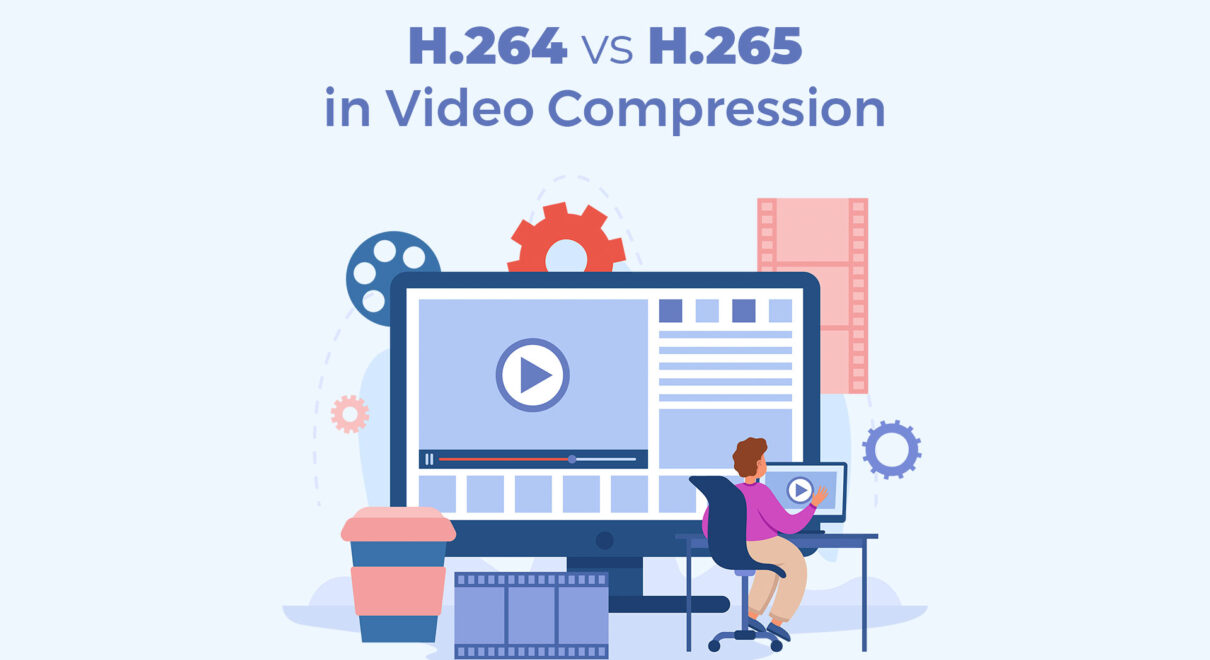Understanding the Evolution
In the rapidly advancing world of digital video, two codecs have become the focal point in the conversation about video compression and quality: H.264 and H.265. These codecs are instrumental in determining the size, quality, and efficiency of digital video, impacting everything from streaming services to video conferencing. This blog post explores the distinctions between H.264 and H.265, shedding light on their functionalities, benefits, and the implications of their differences in the realm of digital video technology.
What are H.264 and H.265?
H.264, also known as Advanced Video Coding (AVC), has been the standard in video compression for over a decade. It’s widely used in everything from Blu-ray discs to internet video streaming. H.265, or High Efficiency Video Coding (HEVC), is its successor, offering enhanced video quality and double the data compression ratio at the same level of video quality.
Other Notable Video Codecs
VP9
Developed by Google, VP9 is an open-source codec. It’s mainly used for video streaming on platforms like YouTube. VP9 is known for its efficiency in streaming high-definition video content at lower bitrates.
AV1
A successor to VP9, AV1 is an open-source and royalty-free video coding format designed for video transmissions over the Internet. It is developed by the Alliance for Open Media and is known for its high efficiency and reduced bandwidth consumption for high-resolution video streaming.
MPEG-2
MPEG-2 is an older codec, primarily used for over-the-air digital television and DVDs. Despite its age, it remains relevant for its wide compatibility, especially in the broadcasting industry.
Apple ProRes
Developed by Apple Inc., ProRes is a high-quality, lossy video compression format favored in professional video editing, particularly for Final Cut Pro users. It is known for its high performance and quality, making it ideal for high-quality projects.
AVC-Intra
Developed by Panasonic, AVC-Intra is designed for professional video recording. It offers high-quality compression, making it suitable for environments like broadcasting where quality cannot be compromised.
DivX
A codec that gained popularity for its ability to compress lengthy video segments into small sizes while maintaining relatively high visual quality. It’s often used for video playback on computers and home theater systems.
Choosing the Right Codec
Selecting the right codec depends on several factors:
Compatibility and Usage Requirements
Some codecs are more suited for editing and post-production, while others are optimized for streaming or broadcasting.
File Size and Quality
Codecs like H.265 and AV1 offer high efficiency, which is crucial for streaming high-resolution video. In contrast, ProRes and MPEG-2 focus more on quality, making them larger in file size.
Hardware and Software Support
Some codecs require more powerful hardware for encoding and decoding. Ensure compatibility with existing systems before choosing a codec.
Key Differences Between H.264 and H.265
Compression Efficiency
H.265 is designed to be more efficient than its predecessor. It can compress video files to about half the size of H.264 while maintaining the same quality. This efficiency is particularly beneficial for 4K and 8K videos, which are becoming more common.
Bit Rate
H.265 delivers a significantly lower bit rate compared to H.264 for the same quality. This reduction is advantageous for streaming services, as it demands less bandwidth and reduces buffering and loading times for viewers.
Support and Compatibility
H.264 is widely supported across various devices and platforms, making it highly compatible and accessible. H.265, while growing in adoption, is not as universally supported yet, requiring more modern hardware for decoding and playback.
Processing Power
Decoding H.265 requires more processing power than H.264. This means that older devices may struggle with playback of H.265 videos, whereas H.264’s lower processing requirements ensure broader compatibility with older hardware.
Video Quality
Both codecs provide high-quality video output, but H.265 has an edge, especially at lower bitrates. Its advanced compression methods allow for better quality at the same bitrate or the same quality at a lower bitrate compared to H.264.
Usage Applications
H.264 is still the go-to choice for most standard-definition to high-definition video applications due to its widespread support and compatibility. In contrast, H.265 is increasingly being adopted for high-resolution video, such as 4K and 8K streaming, due to its superior compression efficiency.
H.264 vs H.265 in Video Compression
The choice between H.264 and H.265 largely depends on the specific requirements of a project, including the desired balance between quality and file size, the necessary compatibility with various devices and platforms, and the available processing power. While H.265 represents a significant step forward in compression technology, offering higher efficiency and better quality at lower bitrates, H.264 remains a reliable and widely compatible choice for a range of applications. As technology continues to evolve, the adoption of H.265 is expected to increase, particularly in areas where high-resolution video is paramount.
Understanding the differences between H.264 and H.265 is crucial for professionals in the video production and streaming industries, as well as for consumers looking to optimize their digital video experiences. As we continue to push the boundaries of what’s possible in digital video, the evolution of these codecs will play a pivotal role in shaping the future of video technology.



